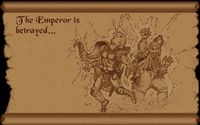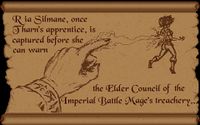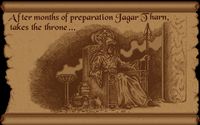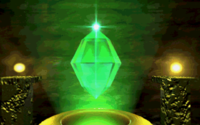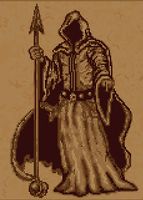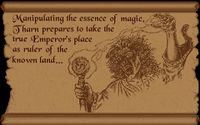Lore:Jagar Tharn
| Jagar Tharn | |||
|---|---|---|---|
 Jagar Tharn
Jagar Tharn |
|||
| Race | Mixed[nb 1] | Gender | Male |
| Born | Valenwood | ||
| Died | 3E 399 Imperial Palace |
||
| Previous Ruler | Welloc | ||
| Next Ruler | Ria Silmane | ||
| Resided in | Imperial City Camlorn |
||
| Appears in | Arena, Shadowkey | ||
Jagar Tharn (pronounced jay-gar tharn[1][2][3][4]) was the Imperial Battlemage of Tamriel and later the Emperor of Tamriel, who secretly imprisoned Emperor Uriel Septim VII, and used Illusion magic to masquerade as Uriel VII for a decade.[3][5][6][7] During Jagar Tharn's reign from 3E 389 to 3E 399, a period known as the Imperial Simulacrum, Uriel VII was held captive in a plane of Oblivion while Jagar reigned over the war-torn Empire.[5][7][8] It is not entirely known what Jagar Tharn's goals and personal accomplishments were during his reign.[7]
Biography[edit]
Background[edit]
—Abnur Tharn, Grand Chancellor of the Elder Council[9]
Jagar Tharn's exact lineage remains unclear.[nb 1] One source states that Jagar was born in southern Valenwood to a Bosmer mother, that he has little human ancestry, and that his racial traits are a result of interracial relationships between elves, specifically Altmer and Dunmer.[10] Additionally, he was said to be a descendant of the Ra'athim Clan of Ebonheart and King Moraelyn.[10] He was a member of House Tharn of Nibenay, a prestigious Imperial family.[11]
At some point prior to his appointment as Imperial Battlemage of Tamriel, Jagar served as a mage-priest at the Temple of Sethiete in Camlorn.[12] Prior to his appointment as Imperial Battlemage of Tamriel, he was possibly a member of the Spire Council, the administrative council of the Battlespire, as it was customary at this time for the future Imperial Battlemage to be selected from the members of the Spire Council.[13]:17
Theft of the Staff of Chaos[edit]
When Jagar Tharn began planning the theft of the Staff of Chaos is unclear. During his time as a mage-priest at the Temple of Sethiete, Jagar stole information on powerful spells, the location of the Staff of Chaos, and how the Staff could be used.[12] Circa 3E 376, a bard known as the Nightingale seduced Queen Barenziah of Morrowind, and she revealed the location of the Staff of Chaos to the Nightingale, who then stole the Staff from its sanctuary beneath the city of Mournhold.[nb 2][14][15][16][17] Queen Barenziah later recognized the Nightingale to be Jagar Tharn.[10][16] However, an alternative account asserts that the bard who stole the Staff of Chaos was actually a master thief named Drayven Indoril, a member of the Nightingale Trinity, and that the truth was covered up for political reasons.[17] After the Staff was given to Jagar, he attempted to kill Drayven, but Drayven escaped.[17] Jagar searched for Drayven but eventually abandoned the search.[17] Nevertheless, both versions of events state that it was Jagar Tharn who was ultimately behind the theft and took possession of the Staff of Chaos.[10][16][17]
Soon after the theft of the Staff of Chaos, Barenziah's consort Symmachus sent urgent communiqués to Uriel Septim VII.[15] Uriel VII expressed shock and displeasure at the Staff's theft and urged Symmachus to make every effort to locate its whereabouts and communicate developments to the newly appointed Imperial Battlemage, who was tasked with tracking down the Staff and those responsible for stealing it.[10]
Imperial Battlemage of Tamriel[edit]
During the two decades after Emperor Uriel Septim VII ascended to the Ruby Throne in 3E 368, he expanded and consolidated Imperial influence and culture throughout the Empire, but especially in Morrowind and Black Marsh.[5][7][18] As Uriel VII's close advisor, Jagar provided shrewd counsel and arcane support to complement the Emperor's ambition and agile mind in these endeavors.[5] Uriel VII, and the Empire, greatly benefited from Jagar's arcane powers and wisdom.[5][19]
Uriel VII eventually surpassed his teacher at balancing the skills of threat and diplomacy, and Jagar's role became less important as time went on.[5] It is believed that he carried on the facade of an out-paced counselor in order to feed Uriel VII's ego and self-assurance and to earn the Emperor's complete trust, all the while Jagar executed his own plans in the background.[5]
In 3E 389, Jagar attended the Mid Year's festival in the Emperor's banquet hall.[20] At the festival, Jagar listened to the leader of the Imperial Guard, General Talin Warhaft, tell an anecdote to Princess Ariella Septim about when his friend, Marten the Blade, used an illusion spell to change his own appearance into that of another, so that Marten might trick a group of bandits into thinking he was their leader.[20] This anecdote served as the inspiration Jagar needed to complete his plan and finally take Uriel VII's place on the Ruby Throne.[20]
As a cover story for his future absence, he requested a leave of absence to pursue magical studies.[20][16] Uriel VII was troubled by the potential absence of his powerful and wise Imperial Battlemage, but nonetheless, he accepted the request, wished him success in his endeavors, and asked only that Jagar select a replacement Imperial Battlemage for the duration of his absence.[20] Jagar appointed Ria Silmane, his oldest apprentice and a powerful mage, to fill his position.[20][16] The appointment was fully approved by the Elder Council.[20]
Betrayal[edit]
Jagar Tharn plotted for months to bring his plan to fruition.[6] Later in 3E 389, he requested to meet with the Emperor to discuss rumors of treachery.[nb 3][6][18] But when Uriel VII and General Warhaft arrived to discuss the rumors of treachery, Jagar used the Staff of Chaos to imprison Uriel VII and General Warhaft in Oblivion.[nb 4][7][5][6][13]:180 Time moved much slower in this plane of Oblivion; thus, it would be centuries before Uriel VII died, and he would experience nothing but inexplicable and haunting nightmares.[5][20][21] When Ria Silmane learned of what Jagar had done to Uriel VII, she attempted to inform the Elder Council, but before she could inform them, Jagar used the Staff of Chaos to kill her.[1][16][6]
With his plot successful, Jagar drained the Staff of Chaos of its power, and he imbued its energy, along with his own life force, into the Jewel of Fire.[1][22] Then, he divided the Staff into eight pieces, and hid them throughout the Empire.[1][16] He took these precautions because the Staff of Chaos was the only item that could be used to free Uriel VII from Oblivion and because if someone did discover his deception, they would have to recover the pieces and reassemble the Staff, only to discover it to be useless without the Jewel of Fire.[1][22] Jagar used Illusion magic to assume the appearance of Uriel VII, and then he took the imprisoned Emperor's place on the Ruby Throne.[6][20][7] He dismissed Uriel VII's inner circle and the Imperial Guards and replaced them with Fire Daemons, whom Jagar cast an illusion spell on to give them the appearance of mortal Imperial Guardsmen.[6][20][21] After his usurpation of Uriel VII, he exiled Uriel VII's wife, Caula Voria, to the Temple of the One, and the imprisoned Emperor's children were dispatched to various prisons across Tamriel.[10]
Emperor of Tamriel and Imperial Simulacrum[edit]
—Pocket Guide to the Empire, 3rd Edition: All the Eras of Man
The Empire suffered terribly during Jagar Tharn's decade-long reign, a period later known as the Imperial Simulacrum.[5][23] Jagar's neglect and mismanagement of Imperial affairs resulted in a steady decline in the Empire's economic prosperity.[5] The decline of Imperial authority in the provinces that accompanied this neglect and mismanagement caused many of the petty lords and kings to take advantage of the situation by engaging in wars of expansion.[5][8] However, little is known of just what Jagar sought to accomplish during this time.[7]
Circa 3E 397, a shadowmage named Skelos Undriel was driven from the Imperial City by Jagar's agents, and Undriel fled to the Western Reach, a region at the time engulfed in the War of the Bend'r-mahk.[24][25] Jagar ordered his agents to track down Undriel.[24][25][26] Undriel hid in the village of Azra's Crossing, but bandits employed by Jagar attacked the village and captured Undriel, but he was later rescued.[24][27] In 3E 397, Jagar and a shadowmage, Pergan Asuul, vied to gain control of the Umbra' Keth, a "Shadow of Conflict", which was created by the ongoing War of the Bend'r-mahk.[26][25][28] To strengthen the Shadow of Conflict and advance Imperial influence in the region, Jagar bribed many prominent families in Hammerfell to support Skyrim in the war.[29][30] To further strengthen the Umbra' Keth, he provided funding for a bandit leader named Lakvan to kill soldiers fighting on the side of Hammerfell.[26][29] Jagar's plans to gain control of the Umbra' Keth were foiled when the Umbra' Keth was destroyed.[28][31]
In 3E 396, Jagar made a deal with the Daedric Prince, Mehrunes Dagon.[32][13]:18 Jagar gave the Battlespire to Mehrunes Dagon, and in exchange, Dagon's forces were required to slay the five battlemage administrators who governed the Battlespire.[32][33][13]:18 Xivilai Moath helped engineer Jagar's involvement in the fall of the Battlespire.[13]:158 He made this deal to eliminate the competition for his position as Imperial Battlemage of Tamriel, as the Battlespire administrators were customarily selected for the position.[13]:17 The deal also served as partial recompense for the assistance that Mehrunes Dagon provided Jagar in his usurpation of Uriel Septim VII.[3][4][34]:2 He had an association with a worshipper of Mehrunes Dagon, the mage Carecalmo, who was involved in Jagar's plot against Uriel VII.[35]
In 3E 398, Jagar Tharn sent one of his retainers, Sirran Angada, to the Battlespire.[3][32][36] Angada used a special transmorph spell to take on the appearance of Lomegan Mariel, Uriel VII's Personal Liaison to the Battlespire, which allowed him to infiltrate the facility.[36][37] At the Battlespire, Angada bribed Paxti Bittor, the Exalted Summoner, to betray the Battlespire to Mehrunes Dagon's forces, and Angada gave the facility's portal keys to the Daedric invaders.[37][38][39] During the invasion, the Daedric forces largely completed Jagar's goal, as only a few of the facility's battlemages, such as Clarentavious Valisious, survived.[40] Once Mehrunes Dagon's forces had captured the Battlespire, Jagar assigned Sirran Angada to read the vagaries of the magicka tides for the Prince of Destruction.[3] An apprentice used Mehrunes Dagon's neonymic to banish him, but when the Legions recaptured the Battlespire in the aftermath of the invasion, the facility was in ruins.[41][42][43][13]:180
Downfall[edit]
As a consequence of the banishment of Mehrunes Dagon, Jagar no longer had Lord Dagon to bolster his regime.[13]:180 When Jagar used the Staff of Chaos to kill Ria Silmane, he destroyed the corporeal form of Ria, but he made the costly mistake of not destroying her spirit.[1][22] Circa 3E 391, the spirit of Ria Silmane appeared in the dreams of Eadwyre, King of Wayrest, and told him of what Jagar had done to her.[nb 5][14][10][16] Ria also told Eadwyre of a friend of hers whom Jagar had ordered imprisoned in the Imperial City Prison, but this prisoner was someone who had the potential to defeat Jagar.[10][16] This prisoner was formerly a minor member of Jagar's Imperial Court, and because of this, he did not view them as a threat.[1] Eadwyre divulged Ria Silmane's information to Queen Barenziah, who had suspicions about the Emperor after an audience with him, and the monarchs formulated a plan to gain Jagar's confidence.[10][16] Jagar was aware of the fact that Barenziah and Eadwyre had deduced that he wasn't Uriel Septim VII.[10] Nonetheless, Barenziah managed to charm and eventually befriend Jagar, which allowed her to slowly learn the locations of the eight pieces of the Staff of Chaos.[10][16] Barenziah also obtained a copy of the key to the cell of Ria's friend, and she bribed a guard to leave the key there.[16]
In 3E 399, Ria Silmane entered the dreams of the prisoner, and she informed them what needed to be done to defeat Jagar Tharn and restore Uriel Septim VII to the throne.[1][21][18] After receiving this information, Ria's Champion escaped their cell by using the ruby key left by the bribed guard, and they escaped the prison by traveling through a Shift Gate.[1][21][44] Ria's Champion was indefatigable and unstoppable in their journey across Tamriel to retrieve the pieces of the Staff of Chaos.[16][45] As the Champion retrieved each piece of the Staff, Jagar used magical visions to threaten and taunt them, and Jagar sent his minions to try and defeat them.[22][45] Finally, the Champion retrieved the final piece of the Staff of Chaos from the mountain of Dagoth-Ur, but when they reassembled the Staff, Jagar mocked them, and he told them that he had drained the Staff of its power.[22][46] He taunted Ria's Champion to confront him in the Imperial Palace and retrieve the Jewel of Fire.[22] The Champion entered the Imperial Palace, and they fought their way through the halls of the Palace until they reached Jagar.[47] The Champion fought Jagar and defeated him, and then they used the Staff of Chaos to drain the power of the Jewel of Fire, which destroyed Jagar Tharn, and Uriel VII was returned to Tamriel.[47][5][7][23] The Emperor named his liberator the Eternal Champion, and granted them a place by his side.[47] On the topic of Jagar Tharn's demise, High Chancellor Ocato reportedly said: "Tharn is dead. He is actually worse off, but I will not discuss those details."[UOL 1]
Legacy[edit]
When Uriel VII returned to the Ruby Throne, he began a period of healing for the Empire known as the Restoration.[5][16][23][33] After his emancipation, Uriel VII worked diligently to reunite Tamriel, although he did so through more subtle means, no longer displaying the brashness he had before his imprisonment.[5][7] Uriel VII stated that his change in strategy and disposition was a reaction to and revulsion to the early teachings and counsel of Jagar Tharn.[5] Due to the audacity and scope of his plot, Jagar was remembered in history as the insane arch-traitor of the Empire.[2][48][49] Uriel VII launched investigations into Jagar's plot, but little information was discovered.[UOL 2] Decades after his death, circa 3E 427, it was rumored that Uriel VII's own heirs had been replaced by Jagar's doppelgangers.[50] Many people were killed when the Imperial Guard charged a mob that demanded the destruction of the "false heirs".[50] Circa 3E 432, the last of Jagar's known associates were prisoners awaiting their deaths in The Rose, an infamous prison in Black Marsh.[51]
Gallery[edit]
Notes[edit]
- Jagar Tharn was known to align himself with The Dark, better known as Padomay or Sithis.[55][UOL 3] One source may imply some connection to the Temple of the One, and another source states that he once served as a mage-priest within the Brotherhood of Setheite.[10][12]
- Early ideas proposed for the Oblivion Crisis story by Michael Kirkbride involved at least one clone-simulacrum of Jagar Tharn and his sleepers as antagonists, with the simulacrum being called Tharnatos Ultimo who resided in the "starry heart of Nirn", whom had ties to the Morag Tong, seemingly via the Tong's simulacrum/incarnation mechanism and their additional ties to Sithis / Padomay / The Dark.[UOL 3][56][UOL 4][UOL 5][UOL 6]
See Also[edit]
Books[edit]
- Brief History of the Empire v 4 by Stronach k'Thojj III — Part 4 of a description of events in the history of the Empire
- A Life of Uriel Septim VII by Rufus Hayn — A short biography of Uriel Septim VII's accomplishments
- The Real Barenziah, v 5 by Anonymous — Unauthorized biography of the famous Queen Mother of Morrowind, Volume 5
- Biography of Barenziah, v 3 by Stern Gamboge, Imperial Scribe — A factual biography of Queen Barenziah, Volume 3
References[edit]
- ^ a b c d e f g h i Ria Silmane's dialogue in Arena
- ^ a b Daggerfall CES Cinematic
- ^ a b c d e Sirran Angada's dialogue in Battlespire
- ^ a b Jauffre's dialogue in Oblivion
- ^ a b c d e f g h i j k l m n o p A Life of Uriel Septim VII — Rufus Hayn
- ^ a b c d e f g Arena Introduction Scene
- ^ a b c d e f g h i Brief History of the Empire, v 4 — Stronach k'Thojj III
- ^ a b Pocket Guide to the Empire, 3rd Edition: All the Eras of Man, A Comprehensive History of our History — Imperial Geographical Society, 3E 432
- ^ Chronicles of the Five Companions 4 — Abnur Tharn
- ^ a b c d e f g h i j k l The Real Barenziah, v 5 — Anonymous
- ^ a b House Tharn of Nibenay — Count Opius Voteporix
- ^ a b c Mystery of Talara, v 4 — Mera Llykith
- ^ a b c d e f g h Battlespire Athenaeum — Ronald Wartow
- ^ a b c d Royal Family Tree, The Daggerfall Chronicles — Ronald Wartow
- ^ a b The Real Barenziah, v 4 — Anonymous
- ^ a b c d e f g h i j k l m n Biography of Barenziah, v 3 — Stern Gamboge, Imperial Scribe
- ^ a b c d e The Nightingales Vol. 2 — Gallus Desidenius
- ^ a b c Tamriel's Timeline, The Daggerfall Chronicles — Ronald Wartow
- ^ A Dance in Fire, v7 — Waughin Jarth
- ^ a b c d e f g h i j French version of Arena's Manual Intro Story
- ^ a b c d e English version of Arena's Manual Intro Story
- ^ a b c d e f Jagar Tharn's dialogue in Arena
- ^ a b c Assassination!
- ^ a b c The Elder Scrolls Travels Shadowkey on the vir2l website
- ^ a b c Skelos Undriel's dialogue in Shadowkey
- ^ a b c Brown Scroll — Jagar Tharn
- ^ Events of Rescue Prisoners in Shadowkey
- ^ a b Cutscenes of Crypt of Hearts III in Shadowkey
- ^ a b Red Scroll
- ^ Events of Bribery Papers in Shadowkey
- ^ Events of the Main Quest of Shadowkey
- ^ a b c Elderscrolls.com Timeline
- ^ a b Elderscrolls.com Archive/Codex
- ^ The Elder Scrolls IV: Oblivion Official Game Guide — Peter Olafson
- ^ Lalatia Varian's dialogue in Morrowind
- ^ a b Jagar Tharn's Letter — Jagar Tharn
- ^ a b Paxti Bittor's dialogue in Battlespire
- ^ Letters for the Battlespire Hero — Vatasha Trenelle or Josian Kaid
- ^ Letter to Mactana
- ^ Clarentavious Valisious' dialogue in Battlespire
- ^ Events of Level 7 in Battlespire
- ^ The Doors of Oblivion — Seif-ij Hidja
- ^ Tamrielic Lore — Yagrum Bagarn
- ^ Events of Imperial Dungeons in Arena
- ^ a b Events of the Main Quest of Arena
- ^ Events of Dagoth-Ur in Arena
- ^ a b c Events of The Imperial Palace in Arena
- ^ Battlespire Introduction Scene
- ^ Response to Bero's Speech — Malviser, Battlemage
- ^ a b Caldera rumors in Morrowind
- ^ Pocket Guide to the Empire, 3rd Edition: The War with the Trees: Argonia and the Black Marsh — Imperial Geographical Society, 3E 432
- ^ Notes on Racial Phylogeny — the Council of Healers, Imperial University
- ^ Aeliah Renmus in ESO: Dragonhold
- ^ Bacaro Volorus in ESO: High Isle
- ^ The Light and the Dark — Irek Unterge
- ^ Dram Character Biography on Redguard.com
Note: The following references are considered to be unofficial sources. They are included to round off this article and may not be authoritative or conclusive.

